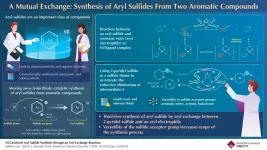Cancer: Information theory to fight resistance to treatments
Researchers from the UNIGE and the HUG have used information theory for the first time to monitor in vivo the development of resistance mechanisms to a cancer-targeted therapy.
2021-07-21
(Press-News.org) One of the major challenges in modern cancer therapy is the adaptive response of cancer cells to targeted therapies: initially, these therapies are very often effective, then adaptive resistance occurs, allowing the tumor cells to proliferate again. Although this adaptive response is theoretically reversible, such a reversal is hampered by numerous molecular mechanisms that allow the cancer cells to adapt to the treatment. The analysis of these mechanisms is limited by the complexity of cause and effect relationships that are extremely difficult to observe in vivo in tumor samples. In order to overcome this challenge, a team from the University of Geneva (UNIGE) and the University Hospitals of Geneva (HUG), Switzerland, has used information theory for the first time, in order to objectify in vivo the molecular regulations at play in the mechanisms of the adaptive response and their modulation by a therapeutic combination. These results are published in the journal Neoplasia.
Adaptive response limits the efficiency of targeted therapies used to fight the development of tumors: after an effective treatment phase that reduces the tumor size, an adaptation to the used molecule occurs that allows the tumor cells to proliferate again. "We now know that this resistance to treatment has a large reversible component that does not involve mutations, which are an irreversible process", explains Rastine Merat, a researcher in the Department of Pathology and Immunology at the UNIGE Faculty of Medicine, the head of the Onco-Dermatology Unit at the HUG and the principal investigator of the study.
Research confronted with the complexity of biological regulations
In order to prevent resistance to targeted therapies, scientists need to understand the molecular mechanisms of the adaptive response. "These mechanisms may involve variations in gene expression, for example", explains Rastine Merat. It is then necessary to modify or prevent these variations by means of a therapeutic combination that blocks the consequences or even prevents them. One challenge remains: the description of these mechanisms and their modulation under the effect of a therapeutic combination is very often carried out on isolated cultured cells and not validated in tumor tissue in the body. "This is essentially due to the difficulty of objectifying these mechanisms, which may occur in a transient manner and only in a minority of cells in tumor tissues, and above all which involve non-linear cause and effect relationships", explains the Geneva researcher.
Applying information theory to tumors
To counter these difficulties, the UNIGE and HUG team came up with the idea of using information theory, more specifically by quantifying mutual information. This approach has previously been used in biology, mainly to quantify cell signaling and understand genetic regulation networks. "This statistical method makes it possible to link two parameters involved in a mechanism by measuring the reduction in the uncertainty of one of the parameters when the value of the other parameter is known", simplifies Rastine Merat.
Practically, the scientists proceed step by step: they take biopsies of tumors (in this case melanomas) in a mouse model at different stages of their development during therapy. Using immunohistochemical analyses - i.e. tumor sections - they measure, using an automated approach, the expression of proteins involved in the mechanism at play in the adaptive response. "The proposed mathematical approach is easily applicable to routine techniques such as immunohistochemistry and makes it possible to validate in vivo the relevance of the mechanisms under study, even if they occur in a minority of cells and in a transient manner", the Geneva researcher explains. Thus, scientists can not only validate in the organism the molecular mechanisms they are studying, but also the impact of innovative therapeutic combinations that result from the understanding of these mechanisms. "Similarly, we could use this approach in therapeutic trials as a predictive marker of response to therapeutic combinations that seek to prevent adaptive resistance", he continues.
A method suitable for all types of cancer
"This method, developed in a melanoma model, could be applied to other types of cancer for which the same issues of adaptive resistance to targeted therapies occur and for which combination therapy approaches based on an understanding of the mechanisms involved are under development", concludes Rastine Merat.
INFORMATION:
[Attachments] See images for this press release:

ELSE PRESS RELEASES FROM THIS DATE:
2021-07-21
In the United States, climate change is controversial, which makes communicating about the subject a tricky proposition.
A recent study by Portland State researchers Brianne Suldovsky, assistant professor of communication, and Daniel Taylor-Rodriguez, assistant professor of statistics, explored how liberals and conservatives in Oregon think about climate science to get a better sense for what communication strategies might be most effective at reaching people with different political ideologies. The study was published in Climatic Change in June.
Prior studies have shown that exposing climate change skeptics, ...
2021-07-21
Over the past six months, the World Health Organization has categorized four SARS-CoV-2 variants as being "of concern" because they are more transmissible or may escape the immune response. They have been termed the Alpha, Beta, Gamma and Delta variants. Scientists from the Institut Pasteur, in collaboration with the French National Health Insurance Fund (CNAM), Ipsos and Santé publique France, conducted a nationwide case-control study to evaluate the effectiveness of mRNA vaccines against symptomatic forms of SARS-CoV-2 infection, be that non-variant virus or the Alpha and Beta variants. The results show that the two-dose vaccination regimen of mRNA vaccines provides 88% protection against non-variant virus, 86% against the Alpha variant and 77% against the Beta ...
2021-07-21
Tsukuba, Japan - Rice is the world's most commonly grown and consumed crop. It also supports lives and livelihoods, especially in low- and middle-income regions. As such, methods for securing abundant and profitable rice harvests are key in global food security.
The System of Rice Intensification (SRI) offers a repeatable, sustainable system for increasing rice yields. It brings together fundamental planting and harvesting techniques such as strategically spacing plants, minimizing water, and transplanting seedlings. These practices can be repeated in varying conditions. While SRI has been around since ...
2021-07-21
Since buildings consume 75% of electricity in the U.S., they offer great potential for saving energy and reducing the demands on our rapidly changing electric grid. But how much, where, and through which strategies could better management of building energy use actually impact the electricity system?
A comprehensive new study led by researchers from the Department of Energy's Lawrence Berkeley National Laboratory (Berkeley Lab) answers these questions, quantifying what can be done to make buildings more energy efficient and flexible in granular detail by both time (including time of day and year) and space (looking at regions across the U.S.). The research team, which also included scientists from the National Renewable Energy Laboratory (NREL), found that ...
2021-07-21
Aryl sulfide, an aromatic compound in which sulfur is attached to an aryl (a functional group derived from an aromatic ring), is found in biologically active materials effective against asthma, Alzheimer's disease, and cancer. As a result, chemists have shown a lot of interest in synthesizing aryl sulfides. Traditionally, carbon-sulfur (C-S) bond formation reactions between thiols and aryl electrophiles catalyzed by transition metals have been employed for aryl sulfide synthesis because of their high reliability. However, thiols have an unpleasant smell and are toxic. Could there be a way to synthesize aryl sulfides that avoids the ...
2021-07-21
A new study of almost 12,000 Australians has found one-third of the adult population has experienced pure cybercrime during their lifetime, with 14% reporting this disruption to network systems in the past 12 months.
With all forms of cybercrime already costing trillions every year globally, experts from the Australian Institute of Criminology (AIC) and Flinders University say the crimes involved substantial levels of personal victimisation including direct losses as well as the high cost of preventing future attacks.
A pre-COVID-19 snapshot of the cost of 'pure cybercrime' in 2019 has found an approximate ...
2021-07-21
Nanomaterials have been used in a variety of emerging applications, such as in targeted pharmaceuticals or to bolster other materials and products such as sensors and energy harvesting and storage devices. A team in the McKelvey School of Engineering at Washington University in St. Louis is using nanoparticles as heaters to manipulate the electrical activity of neurons in the brain and of cardiomyocytes in the heart.
The findings, published July 3, 2021, in Advanced Materials, have the potential to be translated to other types of excitable cells and serve as a valuable tool in nano-neuroengineering.
Srikanth Singamaneni, a materials scientist, and Barani Raman, a biomedical engineer, and their teams collaborated to develop a noninvasive technology that inhibits the electrical ...
2021-07-21
It's hard to save what you can't identify. That's been a problem for the endangered salt marsh harvest mouse, which is found only in the salty, brackish waters of the San Francisco Bay area. The mouse competes for space with about eight million humans, and more than three-quarters of its habitat has been eaten by development and land conversion. That loss is expected to increase amid rising sea levels.
Conserving the population has proven tricky, in part because it looks so much like another mouse in the area--the western harvest mouse--that is abundant throughout western U.S.
But scientists from UC Davis have developed a tool, a "decision ...
2021-07-21
Researchers from the Antimicrobial Resistance (AMR) Interdisciplinary Research Group (IRG) at Singapore-MIT Alliance for Research and Technology (SMART), MIT's research enterprise in Singapore, alongside collaborators from Biobot Analytics, Nanyang Technological University (NTU) and Massachusetts Institute of Technology (MIT), have successfully developed an innovative, open-source molecular detection method that is able to detect and quantify the B.1.1.7 (Alpha) variant of SARS-CoV-2. The breakthrough paves the way for rapid, inexpensive surveillance of other SARS-CoV-2 variants in wastewater.
As the world continues to battle and contain COVID-19, the recent identification of SARS-CoV-2 variants with higher transmissibility and increased severity has made the development ...
2021-07-21
COLUMBUS, Ohio - The parasites that cause severe malaria are well-known for the sinister ways they infect humans, but new research may lead to drugs that could block one of their most reliable weapons: interference with the immune response.
In the study, scientists defined the atomic-level architecture of the connection between a protein on the surface of a parasite-infected red blood cell when it binds to a receptor on the surface of an immune cell.
When that protein-receptor connection is made under normal circumstances, the infected red blood cell, hijacked by the disease-causing parasite, de-activates the immune cell - meaning the body won't fight the infection. A drug designed to fit into that space could block the interaction, allowing the immune system to get to work clearing ...
LAST 30 PRESS RELEASES:
[Press-News.org] Cancer: Information theory to fight resistance to treatments
Researchers from the UNIGE and the HUG have used information theory for the first time to monitor in vivo the development of resistance mechanisms to a cancer-targeted therapy.






